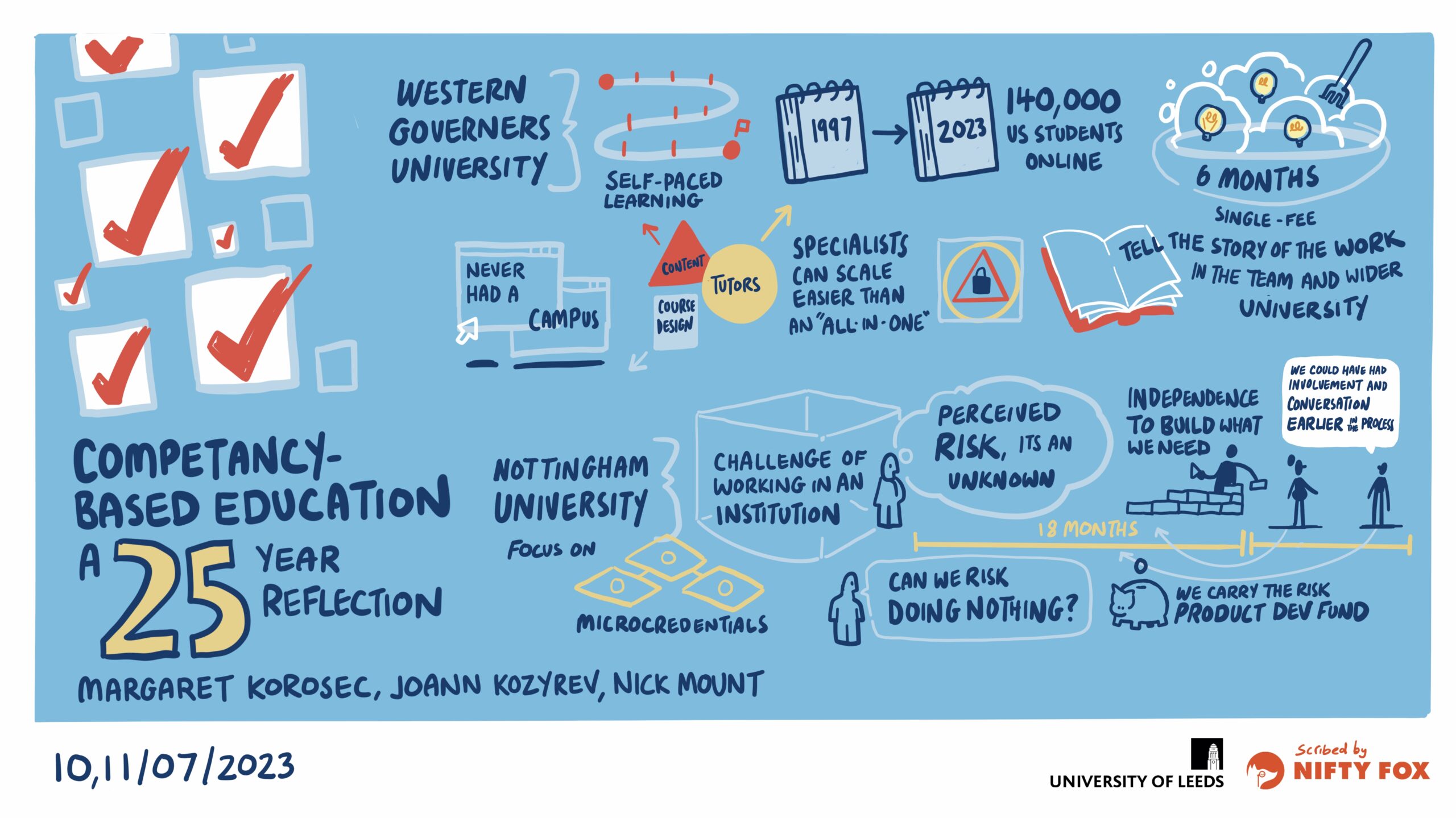Competency-based education (CBE) is a learning approach which empowers students to advance through online study at their own pace, based on their competency – their demonstrated mastery of a skill or subject matter.
It enables students with existing knowledge to choose only to study those elements of a course in which they don’t feel confident, or indeed to skip studying a subject altogether and move immediately to assessment. Conversely, students can choose to spend additional time on a subject if they feel they need to, before proceeding to assessment.
With no requirement for, or tracking of, time spent on or outcomes achieved through study, CBE relies heavily on robust assessment processes. It’s a method which is able to meet different learning abilities and can lead to more efficient and accessible student outcomes.
At #OLS23 we were lucky enough to learn from the 25-year history of Western Governors University (WGU), set up explicitly as a CBE institution and now with 140,000 students, and also to hear about the University of Nottingham’s work to establish a brand new CBE model in the UK.
The regulatory environment seemed to be a key challenge in both cases; in the UK context there are – inevitably – a seemingly endless set of hoops to jump through, while we learned that the work of a now 1000-strong army of assessors in WGU ensuring the assessment process was absolutely watertight was key to securing approval for a CBE approach from their regulators.
Global distance learning
All of this took me back to the early part of my career working at the Edinburgh Business School (EBS) at Heriot-Watt University. Its global distance learning MBA, launched in the early 1990s, was explicitly designed as competency-based learning – though we didn’t call it that at the time! The number of committees and the length of the processes that were needed to get it through layer upon layer of regulatory approval was astonishing.
Assessment was completed by in-person examination, and students were given as much opportunity as possible to work through self-assessment materials in preparation for that formal assessment. That of course included every CBE student’s favourite, the bank of past examination papers, which later formed a hugely popular feature of online versions of the programme.
And critical to the runaway success of the EBS MBA was a shift from an administration system built around managing courses to one built around supporting individual students. Student admin of course remains a bugbear of online learning in higher education to this day.
Can structured semantic learning help?
High-quality competency-based education relies on the provision of a consistent student experience across all courses in a programme. In making decisions about self-paced learning, students need the confidence to easily navigate through content and to efficiently assess their levels of understanding.
Consistency is key, and that’s where a structured semantic learning approach can really pay dividends. And this extends to self-assessment too, another critical feature of CBE learning. Keep all your learning content – including assessment – in a highly structured, standardised form and you can construct pre-study quizzes, formative assessments and practice examinations that are both reliable and replicable. And you can link students who are struggling with a specific concept directly back to the relevant part of the course.
And the semantic side of things can also pay huge dividends. Embed metadata – like how each question relates to each learning objective in your course, for example – and you can provide students with extensive feedback on their progress and clear indications of their readiness for examination. And a handy side-effect is driving up student retention, not to mention making it easier to target tutor support.
One of the small but useful ways that EBS exploited the structured semantic learning content we built for them was to use learning objective weightings on questions to build a picture over time of what subject areas students were struggling with. This data was fed back to the learning development team which was able to build additional learning content to improve student outcomes. What you might call a learning learning environment…
Competency-based education relies on consistent high quality in learning content and assessment, clear progress tracking and reliable revision pathways. The structured semantic learning approach delivers that as standard. It should be a key part of any CBE programme.
What do we mean by structured semantic learning content?
- Building and cherishing your learning materials consistently in a way which captures both structure and meaning.
- Creating learning independent of your current delivery environment, focusing on your pedagogy not your VLE’s features.
- Using efficient publishing techniques to enable your content to be delivered rapidly into your current VLE, your next VLE, in print and in a range of other formats.
- Cleanly and seamlessly combining your unique intellectual property with publishers’ textbook content as required.
- Courseworker by CAPDM is based on structured semantic learning content.



